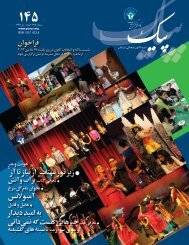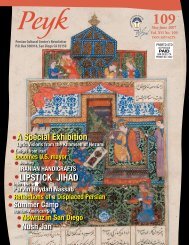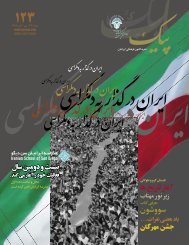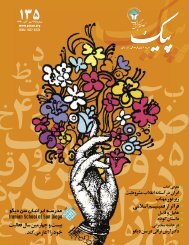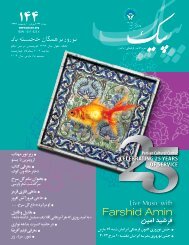English Section - Persian Cultural Center
English Section - Persian Cultural Center
English Section - Persian Cultural Center
You also want an ePaper? Increase the reach of your titles
YUMPU automatically turns print PDFs into web optimized ePapers that Google loves.
Iran’s Path to<br />
Civil Liberties and<br />
Human Rights<br />
Ali Sadr<br />
Translated by Aria Fani<br />
The burst of events and protests following the Iranian<br />
presidential elections on June 12, 2009 led to the formation<br />
of a civil rights movement, known as the Green Movement,<br />
which remains the most significant series of events not only in<br />
the past three decades, but also in the history of contemporary<br />
Iran and the Middle-East. With its multidimensional and<br />
non-violent nature, the Green Movement has written a new<br />
political vocabulary in the history of civil rights movements<br />
around the globe. Sociologists, political and current affairs<br />
analysts will analyze and write about this movement for years<br />
to come. The most distinct features of the Green Movement<br />
are its profound resistance against violence and brutality,<br />
its non-ideological framework, and its lack of leadership.<br />
Who would have envisioned millions of Iranian citizens<br />
marching silently in Tehran, displaying their exceptional<br />
genius by holding their “Where Is My Vote?” placards?<br />
Miraculously, they did not give in to the belligerence and<br />
brutality of the regime, and never counter-responded with<br />
aggression. The world witnessed, time and time again,<br />
that peaceful protesters rushed to protect an entrapped and<br />
disarmed group of riot police from protesters who, in selfdefense,<br />
had resorted to violence. Their level of maturity<br />
and tolerance inspired and moved us. One has to admit that<br />
in such situations, the quickest reaction is to retaliate. For<br />
our generation, aggression has been the counter-response to<br />
aggression. In the past three decades, and as long as Iran’s<br />
history bears witness, civil rights movements have been<br />
silenced by violence, breeding more violence in a cyclical<br />
manner.<br />
We did not believe that the peaceful and non-violent<br />
philosophy of Martin Luther King and Mahatma Gandhi, at<br />
the heart of their respective civil rights movements, could be<br />
put into practice in Iran. Thus we had dismissed their ideas,<br />
even though we were in complete agreement with their nonviolent<br />
approach. It was Malcolm X’s aggressive approach<br />
that we found practical. We strove to emulate the path taken<br />
by the Cubans and Algerians. Guns were sacred. The slogan<br />
of the rebellious, the exhausted dissident, the exuberant<br />
revolutionary was: Where is my gun? They would all sing<br />
in unison: Give me my gun, let the journey begin! …and a<br />
million other variations of the same song. Indeed, there were<br />
many young activists who sacrificed their lives to awaken the<br />
masses and call them to join the cause. But how was “Where<br />
Is My Gun?” transformed into “Where Is My Vote?” Isn’t<br />
this a tremendous evolutionary shift? It is due to the virtue of<br />
the Green Movement’s non-violent uprising that the people<br />
of the world have been watching in solidarity. Not only has<br />
their peaceful movement gained international witness and<br />
sympathy, but has also inflicted irrevocable damage to the<br />
body of the regime by questioning its legitimacy. The world<br />
is finally able to make a clear distinction between the Iranian<br />
people and their regime. A politician is no longer the image<br />
of an entire nation. Iran has a new face, a new image. Now,<br />
what political leader dare wage war on Iran following the<br />
tragic death of Neda Âghâ Soltân on the streets of Tehran?<br />
The world has bowed down to the courage displayed by the<br />
Green Movement.<br />
There are myriad factors that have contributed<br />
to the tremendous shift in the way Iranians demand their<br />
civil rights today. The election of President Obama, a shift<br />
from the international politics of intimidation to diplomatic<br />
dialogues, has undoubtedly been an important factor. The<br />
importance of women’s participation in propelling this<br />
movement can never be emphasized adequately. In recent<br />
years, the women’s equal rights campaign has persistently<br />
established itself as one of the world’s largest nonviolent<br />
civil rights movements. Women’s rights activists have been<br />
integral to the progress and maturity of the Green Movement.<br />
In addition, the movement’s youthful exuberance and<br />
resistance towards ideologies, and its iconoclastic nature,<br />
have also been vital factors in its survival and development.<br />
The movement’s most fundamental demand, give me back<br />
my vote, has gradually engendered other basic human rights<br />
demands such as freedom of speech, freedom of assembly,<br />
and freedom of press. These demands are often sought within<br />
the framework of the constitution, underlining the fact that<br />
the Green Movement does not strive to overthrow the regime.<br />
Another feature of this movement has been its creative usage<br />
of Internet networks and other communication tools to<br />
10 No. 128/ July-August 2010



